BANJO MATTHEWS
02-14-1932 - 10-02-1996

was a native of Akron, Ohio, had a high degree of success behind the wheel of Modified race cars, winning hundreds of races during his career, but his primary claim to fame is the cars he built for others to drive. His shop, Banjo's Performance Center near Asheville, NC, is perhaps the second-most famous building in town, running a close second to the prestigious Biltmore House. After moving to Miami from Ohio, he ran his first race at age 15 in a Ford Roadster at Pompano Beach Speedway in 1947, and won, After five years of racing and working on cars, Matthews decided he wanted to race for a living, and moved to the 1963 season, posting
three top five finishes. In 1965 Ned Jarrett was hired to drive for Long, and the duo make a strong combination. Jarrett would drive the full season and post 14 wins; and finish second on seven other occasions. He finished second in the series points. 1965 saw Jarrett post 13 more victories, and 12 runner up finishes, and win the Cup series Championship. Ned Jarrett and his car were featured on the first ever cover of Stock Car Racing magazine. Long cut way back on his racing in 1966 and only field cars for eleven races, with Jarrett running nine of them and finish third three times. Dick Hutcherson, and Mario Andretti also each drove one. 1967 saw Hutcherson do a majority of the driving as he would drive in 31 races, and visit victory lane twice. Hutcherson would finish third in the points chase. 1968 would be Long's final year as a car owner. He fielded
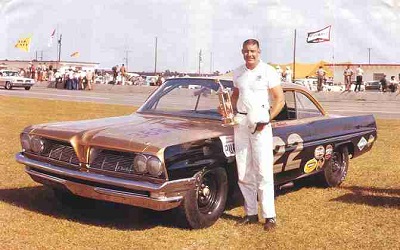
Fireball Roberts 1961
cars for such talented drivers as Bobby Allison, Bud Moore, and AJ Foyt; but these drivers combined only ran a total of 16 races. In 206 races that Long fielded cars, they saw the winners circle on 29 occasions, along with 30 second place finishes. They also posted 114 Top 5 finishes, and 134 Top 10 finishes. Asheville, NC in 1952. He raced both dirt and asphalt, building a reputation as one of the best modified drivers around, and he was ready when NASCAR went to the superspeedways in the early 1960's. Banjo raced 50 times on the Grand National circuit, with a second at Atlanta
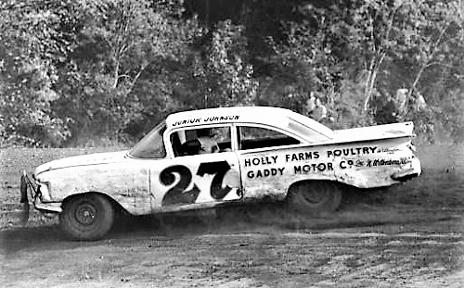
Junior Johnson 1964
being his closest encounter with victory lane. In 1963, he left the driving to others, joining the Ford factory team building cars for Parnelli Jones, A. J. Foyt, Donnie Allison, Pete Hamilton and Bobby Isaac. When the factories pulled out, Banjo opened his own shop, and the legend began. He made a deal with John Holman of Holman-Moody, and built kit-type Fords in 1971. Matthews built the body and framework, and H-M put in the motors. After that, he built cars for Chevrolet. Cars owned by Matthews won nine races and 14 poles in 160 starts, including three Firecracker 400's at Daytona. But he decided to turn all of his energies to building cars for others to own, and that is when he really made a name for himself. Cars built by Matthews won 262 of 362 NASCAR Winston Cup races from 1974-
1985, including all 30 races in 1978, and four consecutive Winston Cup championships (1975-78). Craftsmanship was Matthews' hallmark. He treated each car like a bottle of fine wine. "When I was driving I couldn't stand to get outrun by somebody with better equipment," he said in 1980. "That's the way I feel about my business. I believe in and admire craftsmanship. Banjo built and raced his own cars from 1957-1962. He never posted a win and his best finish came in his fifth career race - he finished third at North Wilkesboro. When he retired from driving in 1963 he hired such notable drivers as Speedy Thompson, Fireball Roberts, Junior Johnson, Cale Yarborough, Bobby Isaac and Donnie Allison to wheel his race cars. Fireball Roberts got Matthews his first win as a car owner by claiming the trophy in the Fire Cracker 400. Junior Johnson would win twice in 1964 driving a Matthews machine while Donnie
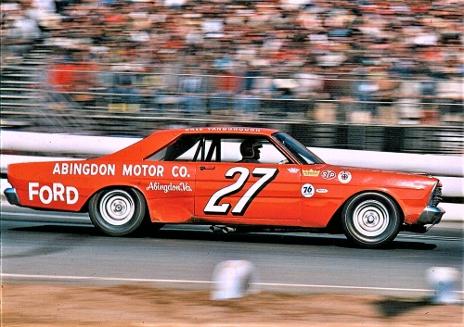
Cale Yarborough 1966
Allison would visit victory lane once in 1969 and an additional three times in 1970. His biggest win came when Allison claimed the World 600 trophy at Charlotte in 1970. It was Banjo Matthews who gave Donnie his big break in 1968. Donnie said Banjo was the best thing that ever happened to him and Banjo was the smartest man he had ever been around in Winston Cup. He enjoyed the best season of his career in 1970 while driving for Matthews. Allison never competed in more than 21 races in a single season, won the World 600 at Charlotte, the Firecracker 400 at Daytona
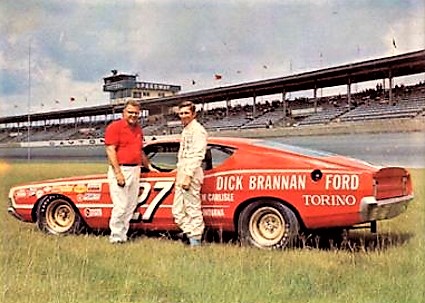
Donnie Allison 1969
and the Southwestern 400 at Bristol that year and in 19 starts, Allison had 10 top five finishes. Also of not NASCAR went to Matthews and asked him to build specially prepared cars for their IROC Series. All the cars were identically-prepared, evenly matched stock cars of the same make and model, set up by a single team of technicians (historically, NASCAR veterans Dick Trickle, Dave Marcis and Jim Sauter) so driver talent would determine who would win. Banjo Matthews had a sign in his race shop: "Banjo's, where money buys speed - How fast do you want to go?!" In the months before he died of heart and respiratory disease in 1996, he was honored by being awarded the Buddy Shuman Award, the Smokey Yunick Award for lifetime mechanical achievement, and has been inducted into the NMPA Hall of Fame at Darlington. Matthews' son, Jody, 31, (who accepted the
hall of fame award in his father's absence) continues to operate the business, building cars and suspension parts. "My dad was real emotional about the hall of fame and I'm just so happy that he got to enjoy the honor before he passed away," says Jody. "He never was a trophy-chaser, but he appreciated recognition by his peers. At right is one of the IROC cars built by Matthews. In 1977, Penske and IROC commissioned legendary NASCAR driver/builder Banjo Matthews to build new Camaros from the ground up. The new machines were complete tube frame race cars covered predominantly with fiberglass panels, powered by a re-worked, Traco-built 350-cid Chevy mill good for
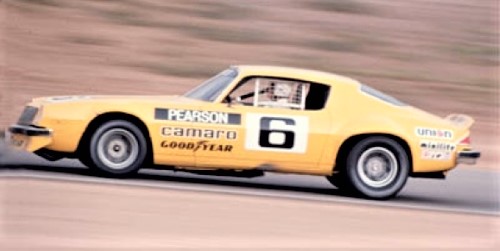
450hp. The bodywork, T-10 4-speed gearbox, race suspension, Hurst-Airheart 4-wheel disc brakes and steering box came straight from GM’s parts bin. Fifteen IROC 2nd-Gen Camaros were built, racing the series until 1980.
All Photos copyright and are property of their respective owners
